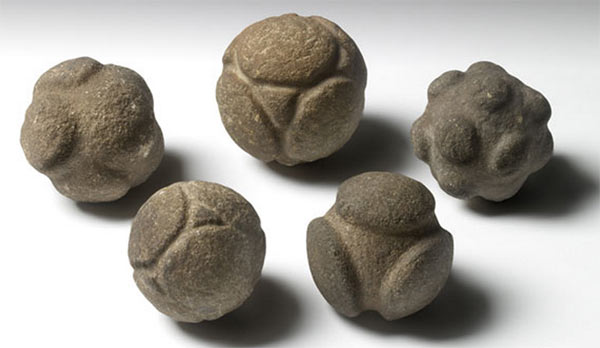Could the Strange Prehistoric Carved Stone Balls Represent Atoms?
Five carved stone balls are part of the collection at the Ashmolean Museum that were discovered in Scotland (Kincardineshire, Aberdeenshire and Banff). The purpose of those objects is unknown and is baffling archaeologists.
They are made of different stones like sandstone and granite and they are dated back to the Neolithic period between 3000 and 2000 BC. More than 400 stones have been found in Scotland and, including the five stones of the Ashmolean Museum, they have something peculiar about them.
Just recently, scientists have created 3D models of the enigmatic stone balls. Their new models also show some previously hidden patterns and other details that could not be appreciated by the naked eye. In total, 60 models have been made, including the most famous of the stone ball collection, the Towie ball.
As you can see in the picture, there are engraved symmetrical patterns around the surface of the stones.
 Most of the stones are of similar size with a diameter of 70mm with the exception of a few larger ones up to 114mm in diameter. The number of knobs on the stones varies from 4 up to 33 with some of the stones also including strange spiral patterns. The stone in the image was found at Skara Brae on Orkney and dates back to 3400 to 2000 BC.
Most of the stones are of similar size with a diameter of 70mm with the exception of a few larger ones up to 114mm in diameter. The number of knobs on the stones varies from 4 up to 33 with some of the stones also including strange spiral patterns. The stone in the image was found at Skara Brae on Orkney and dates back to 3400 to 2000 BC.
Another famous stone is the Towie Stone that was found on Glas Hill in Aberdeenshire. It is about 3 inches in diameter and contains three embossed round surfaces but each surface includes multiple spiral-like symbols. This stone is also dated back to 2500 to 1900 BC.
The five stones of the Ashmolean museum were part of the collection of Sir John Evans who thought that they have been used probably during war attached to a thong. However such an explanation doesn’t make sense because a) the stones found have zero damage on them, which wouldn’t be the case if they were thrown during war times and b) it would require much skill to prepare even one of those stones just to throw them to the enemy.
 Other explanations include that they were used as weights for fishing nets or had a ceremonial role giving the holder the right to speak. But again using the stones as weight wouldn’t explain the complexity of making them.
Other explanations include that they were used as weights for fishing nets or had a ceremonial role giving the holder the right to speak. But again using the stones as weight wouldn’t explain the complexity of making them.
There is another possible explanation though. Could they be models of the nucleus of atoms? Such a representation of atoms has been widely used in our times as shown in the example image on the left. Is it possible that whoever made those objects had knowledge of chemistry and could represent the atomic structure of different atoms?
 At the very least, the embossed symmetrical patterns suggest that whoever made those objects had knowledge of geometry and may even have been able to represent the platonic solids, regular, convex polyhedrons where the faces are congruent, regular polygons, with the same number of faces meeting at each vertex. But in all those cases we know during the Neolithic period that such a knowledge couldn’t exist…. or could it?
At the very least, the embossed symmetrical patterns suggest that whoever made those objects had knowledge of geometry and may even have been able to represent the platonic solids, regular, convex polyhedrons where the faces are congruent, regular polygons, with the same number of faces meeting at each vertex. But in all those cases we know during the Neolithic period that such a knowledge couldn’t exist…. or could it?
For now, their true purpose remains a mystery.
By John Black
Related Links
Carved Stone Balls from Scotland


















Comments
Ancient Armies of all Empires were using units of soldiers that were throwing such pieces against enemies. The last empire that used them was The Roman Empire, such soldiers(Called Funditores) who were throwing such pieces(called Glandes) against the enemy. The tool used to throw that pieces made of lead, stone or cement, was the sling. The pieces were so shaped with striations to be better fixed in the strings of the sling. The pieces(roman Glandes) made of lead had writings on them (name of the thrower, of the roman Legion, or other). The price of Glandes was big and the soldiers were searcing for them after the fight, to deposit them back in the armies facilities. The number of Glandes was big and there’s weight very big and the roman army used horses to carry them. This is why big amounts of Glandes were found in the same place. For more, read “Comentarii de Bello Gallico” by C. Iulii Caesaris(first Roman Emperor)
Victor-Ion
I lean towards the idea of oracle stones or perhaps they're a master stone carver's final exam?
Thinking about it, it gets kind of cold in this part of the world in Winter, there wasn't any double glazing. I wonder if the crafting these stones was a pasttime and had a practical use also: hand warmers, they seem about the right size, throw them in the fire and then wrap them in cloth to keep your hands warm, some are very ornate but some quite crude. All the stones seem to be quiet hard, but you could rub two hard stones together to create these wonderful shapes, because this would take some considerable time to do you can see that they have thought about it, I can see someone passing time around a fire on an evening to make one, they didn't have TV, watching the stars or doing something like this a past-time before retiring, may be?
I had a girlfriend at college that used to buy chips (or chip as she called them), she didn't eat them they were to keep her hands warm on a cold winter night on a walk home.
I like all these comments, they are very creative like the people that crafted these rather intriguing objects. My first thought was a weapon, however looking at more of them there are many that are not spherical, but appear to be sized to fit in the palm. They reminded me of an Orb held by a monarch. Further details here: https://en.wikipedia.org/wiki/Globus_cruciger
The history suggests this was as a known symbol of power in pre-Christian times also, so I wonder if it was also used in ancient times as a symbol of authority by a Chieftain?
I found the globes with spirals interesting, Minoans used spirals to represent the movement of currents, if these were found on islands I wonder if they have a similar meaning? Although I would not have expected this, the same iconography is used in Newgrange which suggests there may have been some form of contact or exchange between the med and peninsular around this time. Which actually makes a lot of sense, the Minoans had similar (in some senses better) maritime navigational skills and seaworthy ships for long distance voyages as the Phoenicians, the later were known to visit the tin islands and they largely learned this from the seafaring Philistines that were Minoans. In fact the first known use of name Britain appears in their records, similarly, the Minoans had a minor deity called Britomartis, which is associated with and sometimes shown above the Mistress of the West, Artemis. I wonder if this is a reference to Navigating to the Pillars of Hercules and then heading North to the other source of Tin.
Could these perhaps be strains of viruses? Maybe the culture was dying and they tried to record the microscopic display of the pathogens killing the people. This could be a complex way of warning furture intelligent generations of dangerous plagues. Maybe these are anti-viral agents on a microscopic scale? Maybe analyzing the structures and compare with known recorded virus structures could show a match. One looks like a human T-cell.
Solipsist
Pages